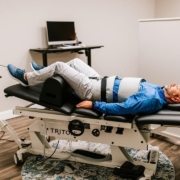Decompression Therapy: An Innovative Approach to Relieving Spinal Discomfort
In our fast-paced modern lives, many of us find ourselves struggling with various types of physical discomfort, especially related to our spinal health. Whether it’s due to poor posture, sedentary lifestyles, or injuries, spinal discomfort can significantly impact our daily lives. However, with advancements in medical technology, a revolutionary treatment known as decompression therapy has emerged as a promising solution for many individuals seeking relief from back and neck pain. In this article, we will delve into what decompression therapy is, how it works, and its potential benefits.
Understanding Decompression Therapy:
Decompression therapy is a non-invasive, drug-free treatment modality that aims to alleviate pressure and discomfort on the spine. This therapy is primarily used to treat conditions such as herniated discs, bulging discs, degenerative disc disease, sciatica, and facet joint syndrome. It offers a safe alternative to surgery and provides a gentle and controlled approach to spinal decompression.
The Process of Decompression Therapy:
During a decompression therapy session, a patient is carefully positioned on a specialized table. The table is equipped with a computer-controlled traction system that applies gentle pulling forces to the spine. By doing so, decompression therapy creates a negative pressure within the affected spinal discs, encouraging the retraction or repositioning of herniated or bulging discs. This action helps to reduce pressure on nerves, enhance blood flow, and promote the delivery of essential nutrients to the injured areas.
The controlled traction force applied during decompression therapy can be customized to meet the specific needs of each patient. The therapy session typically lasts between 15 and 45 minutes, depending on the severity of the condition and the recommendations of the healthcare professional.
Benefits of Decompression Therapy:
- Pain Relief: One of the primary objectives of decompression therapy is to relieve pain associated with spinal conditions. By reducing pressure on nerves and improving blood flow, this therapy can significantly alleviate discomfort in the neck, back, and legs.
- Non-Invasive Approach: Unlike surgical interventions, decompression therapy is a non-invasive treatment option. It avoids the risks and complications associated with surgery, making it an appealing alternative for individuals seeking conservative treatment options.
- Improved Mobility and Function: By addressing the underlying causes of spinal discomfort, decompression therapy can enhance joint mobility and functional abilities. This improvement allows individuals to engage in daily activities with less pain and increased range of motion.
- Avoidance of Medication Dependency: Decompression therapy focuses on targeting the root cause of spinal pain rather than relying on medication to mask the symptoms. By reducing the need for pain medication, individuals can avoid potential side effects and long-term dependency.
- Cost-Effective Solution: In comparison to surgical procedures, decompression therapy is often more cost-effective. It reduces expenses related to hospital stays, post-operative care, and the recovery period.
Conclusion:
Decompression therapy offers a non-invasive and promising approach to relieving spinal discomfort. By gently decompressing the spine, this innovative treatment helps to alleviate pain, enhance mobility, and improve overall quality of life. Although decompression therapy may not be suitable for everyone, consulting with a healthcare professional can provide valuable insights into whether it may be an appropriate treatment option for your specific spinal condition. Remember, taking care of your spine is crucial, and exploring non-invasive alternatives like decompression therapy can be a significant step toward a pain-free and active lifestyle.

